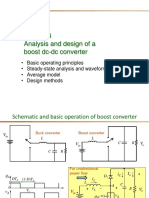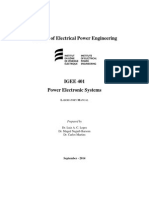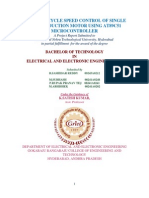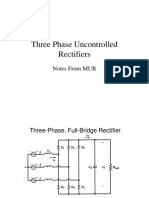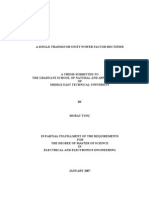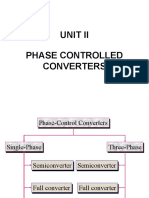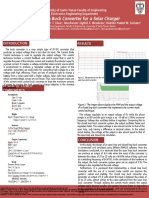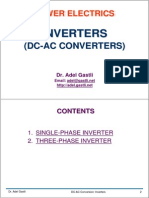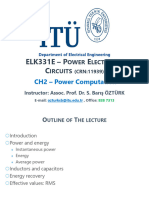Power Computations
EE328 Power Electronics
Assoc. Prof. Dr. Mutlu BOZTEPE
Ege University, Dept. of E&E
Outline of lecture
Introduction
Power and energy
EE328 POWER ELECTRONICS
– Instantaneous power
– Energy
– Average power
Inductors and capacitors
Energy recovery
Effective values: RMS
Apparent power and power factor
Power computations for sinusoidal AC circuits
Power computations for non-sinusoidal periodic
waveforms
– Fourier series
– Non-linear source and linear load
– Linear source and non-linear load
EE328 Power Electronics, Dr. Mutlu Boztepe, Ege University, 2016 2
1
� Introduction
Power computations are essential in analyzing and designing power
electronics circuits.
The power calculation methods differ according to the current and
voltage waveforms
– DC
– sinusoidal voltages and currents
– non-sinusoidal voltages and/or currents
Various definitions of power
– Instantaneous power
– Average power
– Active power
– Reactive power
– Apparent power
– Complex power
– and so on.
EE328 Power Electronics, Dr. Mutlu Boztepe, Ege University, 2016 3
AC & DC quantities
If the value of any electrical quantity (voltage, current etc.) doesn’t
change with respect to time, it is a DC quantity.
If the value of any electrical quantity vary with time, it is an AC
quantity.
EE328 Power Electronics, Dr. Mutlu Boztepe, Ege University, 2016 4
2
� Instantaneous power
The power is defined as the product of current and voltage
This equation is valid for any device
or any circuit.
The instantaneous power is the value
of power p(t) at any instant of time.
The instantaneous power is generally
a time-varying quantity.
The power has negative or positive
value with respect to the time.
The sign of the power indicates its
direction of flow.
EE328 Power Electronics, Dr. Mutlu Boztepe, Ege University, 2016 5
Sign conventions
Passive sign convention (Used frequently for passive components)
At any instant of time;
– if p(t)>0, it indicates the device is absorbing power
– if p(t)<0, it indicates the device is supplying power
Active sign convention (Used frequently for sources)
At any instant of time;
– if p(t)<0, it indicates the device is absorbing power
– if p(t)>0, it indicates the device is supplying power
Only difference between the conventions are the
reference direction of current i(t).
EE328 Power Electronics, Dr. Mutlu Boztepe, Ege University, 2016 6
3
� Exercise 1
Calculate the power
of all components
in the circuit.
Active sign convention Passive sign convention
EE328 Power Electronics, Dr. Mutlu Boztepe, Ege University, 2016 7
Energy
Energy, or work, is the integral of instantaneous power.
Observing the passive sign convention, the energy absorbed by a
component over the time interval from t1 to t2 is
where v(t) is in volts, i(t) is in amperes, power has units of watts and
energy has units of joule.
EE328 Power Electronics, Dr. Mutlu Boztepe, Ege University, 2016 8
4
� Average Power
Periodic voltage and
current functions produce
a periodic instantaneous
power function.
Average power is the time average of p(t) over one or more periods.
Also computed from energy per period
EE328 Power Electronics, Dr. Mutlu Boztepe, Ege University, 2016 9
Exercise 2
Voltage and current, consistent with the passive sign convention, for
a device are shown below.
a) Determine the instantaneous power p(t) absorbed by the device.
b) Determine the energy absorbed by the device in one period.
c) Determine the average power absorbed by the device.
EE328 Power Electronics, Dr. Mutlu Boztepe, Ege University, 2016 10
5
� Solution (1)
a) Instantaneous voltage¤t
Instantaneous power
EE328 Power Electronics, Dr. Mutlu Boztepe, Ege University, 2016 11
Solution (2)
b) The energy absorbed by the device can be found by integration of
instantanous power p(t) over the period.
c) The average power is determined as follows;
or alternatively;
EE328 Power Electronics, Dr. Mutlu Boztepe, Ege University, 2016 12
6
� DC voltage source
The average power absorbed by a dc voltage source is
Bringing the constant Vdc outside of the integral gives
Therefore, average power absorbed by a dc voltage source is
the product of the voltage Vdc and the average current Iavg .
EE328 Power Electronics, Dr. Mutlu Boztepe, Ege University, 2016 13
Exercise 3
Assume that the voltage and current waveforms of a DC voltage
source is;
The average power delivered by this voltage source can be found as
EE328 Power Electronics, Dr. Mutlu Boztepe, Ege University, 2016 14
7
� Resistor
It doesn’t cause a phase difference between voltage and current.
A dissipative device in electric circuits which obeys Ohm’s law,
The power absorbed by
a resistor is
EE328 Power Electronics, Dr. Mutlu Boztepe, Ege University, 2016 15
P, V and I for a resistor
EE328 Power Electronics, Dr. Mutlu Boztepe, Ege University, 2016 16
8
� Inductors and capacitors
Inductors and capacitors have some particular characteristics that
are important in power electronics applications.
They are able to store energy,
Inductors store energy Capacitors store energy
in magnetic field in electric field
EE328 Power Electronics, Dr. Mutlu Boztepe, Ege University, 2016 17
Inductor’s average power
If the inductor current is periodic, the stored energy at the end of one
period is the same as at the beginning.
No net energy transfer indicates that the average power absorbed
by an inductor is zero for steady-state periodic operation.
Instantaneous power is not necessarily zero because power may
be absorbed during part of the period and returned to the circuit
during another part of the period.
EE328 Power Electronics, Dr. Mutlu Boztepe, Ege University, 2016 18
9
� P, V and I for an inductor
EE328 Power Electronics, Dr. Mutlu Boztepe, Ege University, 2016 19
Inductor’s average voltage
From the voltage-current relationship for the inductor
Therefore, for periodic currents, the average voltage across an
inductor is zero.
This is very important
conclusion which is used
in the analysis of
switching converters
EE328 Power Electronics, Dr. Mutlu Boztepe, Ege University, 2016 20
10
� Inductor packages
EE328 Power Electronics, Dr. Mutlu Boztepe, Ege University, 2016 21
Capacitor’s average power
If the capacitor voltage is periodic, the stored energy is the same at
the end of a period as at the beginning.
Therefore, the average power absorbed by the capacitor is zero for
steady-state periodic operation.
Instantaneous power is not necessarily zero because power may
be absorbed during part of the period and returned to the circuit
during another part of the period.
EE328 Power Electronics, Dr. Mutlu Boztepe, Ege University, 2016 22
11
� P, V and I for a capacitor
EE328 Power Electronics, Dr. Mutlu Boztepe, Ege University, 2016 23
Capacitor’s average current
From the voltage-current relationship for the capacitor,
Therefore, for periodic currents, the average current that flows
through a capacitor is zero.
This is very important
conclusion which is used in the
analysis of switching converters
EE328 Power Electronics, Dr. Mutlu Boztepe, Ege University, 2016 24
12
� Capacitor types
EE328 Power Electronics, Dr. Mutlu Boztepe, Ege University, 2016 25
Capacitor packages
EE328 Power Electronics, Dr. Mutlu Boztepe, Ege University, 2016 26
13
� Exercise 4 - Power and Voltage for an Inductor
The current in a 5-mH inductor is the periodic triangular wave as
shown below.
Determine the voltage, instantaneous power, and average power for
the inductor.
EE328 Power Electronics, Dr. Mutlu Boztepe, Ege University, 2016 27
Solution (1)
The current-voltage relationship
of an inductor is
By using this relationship, the
voltage across the inductor can
be found as shown in the figure
on the right.
It can be determined easily from
the figure that the average
inductor voltage is zero
EE328 Power Electronics, Dr. Mutlu Boztepe, Ege University, 2016 28
14
� Solution (2)
The instantaneous power in the
inductor is
when p(t) is positive, the inductor is
absorbing power,
when p(t) is negative, the inductor is
supplying power.
The average inductor power is zero.
EE328 Power Electronics, Dr. Mutlu Boztepe, Ege University, 2016 29
Energy recovery
Inductors and capacitors must be energized and de-energized in
several applications of power electronics.
For a periodic operations, the net energy in inductors and capacitors
must be zero in steady-state condition, otherwise the current or
voltage ramps up, and can easily destroy the sensitive devices.
For example, a fuel injector solenoid in an automobile is energized
for a certain time interval by a transistor switch.
During this time interval, energy is stored
in the solenoid’s inductance.
The circuit must be designed to remove
the stored energy in the inductor while
preventing damage to
the transistor
when it is turned off.
EE328 Power Electronics, Dr. Mutlu Boztepe, Ege University, 2016 30
15
� Solenoid switching
The solenoid can be modelled as an inductor. The resistance
associated with the inductor is assumed to be negligible
Transistor switch and diode are assumed to be ideal.
The diode-resistor path provides a means of opening the switch and
removing the stored energy in the inductor when the transistor turns
off.
Without the
diode-resistor path,
the transistor could
be destroyed
when it is turned off
EE328 Power Electronics, Dr. Mutlu Boztepe, Ege University, 2016 31
Circuit operation: 0<t<t1
Inductor voltage is equal to the supply voltage Vcc. Therefore the
current can be calculated as follows,
The transistor current is equal to
the inductor current
Inductor and source currents
thus increase linearly Transistor
when the transistor is on. is ON
EE328 Power Electronics, Dr. Mutlu Boztepe, Ege University, 2016 32
16
� Circuit operation: t1<t<T
This is a simple RL circuit, so that the inductor current can be
calculated as follows
Time constant
The initial value of inductor
current is
The current in the inductor
and resistor is decaying
exponential with
time constant L/R.
The switch current is zero
EE328 Power Electronics, Dr. Mutlu Boztepe, Ege University, 2016 33
Average DC source power
The current waveform supplied by the DC source is
The average power supplied by the DC source is
EE328 Power Electronics, Dr. Mutlu Boztepe, Ege University, 2016 34
17
� Average resistor power (Method 1)
The average power absorbed by the resistor could be determined by
integrating an expression for instantaneous resistor power, but an
examination of the circuit reveals an easier way.
The average power absorbed
by the inductor is zero
The power absorbed by
the ideal transistor and
diode are both zero.
Therefore, all power
supplied by the source
must be absorbed
by the resistor
EE328 Power Electronics, Dr. Mutlu Boztepe, Ege University, 2016 35
Average resistor power (Method 2)
Another way to approach the problem is to determine the peak
energy stored in the inductor,
The all energy stored in the inductor is transferred to the resistor
while the transistor switch is open.
Power absorbed by the resistor can be determined from
EE328 Power Electronics, Dr. Mutlu Boztepe, Ege University, 2016 36
18
� Efficiency considerations
All the energy stored in the inductor is dissipated in the resistor, and
converted to heat.
Therefore, the energy efficiency is very low for resistive energy
recovery circuits.
The circuit efficiency can be improved if stored energy in the
inductance can be transferred back to the source rather than
dissipating in resistor.
The circuit below can be
used for this purpose
Two transistor switches
are turned on
and off
simultaneously.
EE328 Power Electronics, Dr. Mutlu Boztepe, Ege University, 2016 37
Circuit operation: 0<t<t1
Inductor voltage is equal to the supply voltage Vcc. Therefore the
current can be calculated as follows,
The transistor current is equal to
the inductor current
ON
Inductor and source currents ON
thus increase linearly
when the transistors are on.
EE328 Power Electronics, Dr. Mutlu Boztepe, Ege University, 2016 38
19
� Circuit operation: t1<t<2t1
Inductor voltage is vL(t)= –Vcc ,then the current can be found as,
The source current is negative
then the source is absorbing
power.
Average source current is zero,
resulting in an average
source power of zero.
No energy losses!!!
EE328 Power Electronics, Dr. Mutlu Boztepe, Ege University, 2016 39
Exercise 5
In the following circuits Vcc=90 V, L=200 mH, R=20, t1=10 ms,
and T=100 ms. Determine,
a) the peak current and peak energy storage in the inductor
(Ans. 4.5A, 2.025J)
b) the average power absorbed by the resistor,
(Ans. 20.25W)
c) the peak and average
power supplied by the source.
(Ans. 405W, 20.25W)
d) Compare the results with
what would happen if
the inductor were energized
using lossless two
transistor circuit.
EE328 Power Electronics, Dr. Mutlu Boztepe, Ege University, 2016 40
20
� Effective value: RMS
The effective value of a periodic voltage waveform is based on the
average power delivered to a resistor.
For a periodic voltage across a resistor, effective voltage is defined
as the voltage that is as effective as the dc voltage in supplying
average power.
Both voltages Veff and Vdc produce same average power on the
load.
However, Veff is a quantity which corresponds to the effective value
of the ac source v(t)
EE328 Power Electronics, Dr. Mutlu Boztepe, Ege University, 2016 41
Effective value: RMS
Average power on the resistor is
Equating the expressions for average power
Then we obtain the definition formula of the effective value as
follows
RMS: Root-Mean-Square
EE328 Power Electronics, Dr. Mutlu Boztepe, Ege University, 2016 42
21
� Effective value: RMS
Similarly, the RMS current is developed from P=I2rmsR
as,
The usefulness of the RMS value is that it doesn’t vary
with time.
Thus, the AC circuits can be analyzed as like DC circuits
by using RMS values of voltages and currents in the
circuits.
Additionally, ratings of devices such as transformers are
often specified in terms of RMS voltage and current.
EE328 Power Electronics, Dr. Mutlu Boztepe, Ege University, 2016 43
Exercise 6
Determine the rms value of the periodic pulse waveform that has a
duty ratio of D as shown below.
Solution: The voltage is expressed as
The rms value is then calculated
EE328 Power Electronics, Dr. Mutlu Boztepe, Ege University, 2016 44
22
� Exercise 7
Determine the RMS Value of a sinusoidal voltage of v(t)=Vm sin(wt)
RMS value of a full-wave
rectified sinewave
v(t)=|Vm sin(wt)| is same
EE328 Power Electronics, Dr. Mutlu Boztepe, Ege University, 2016 45
Exercise 8
Determine the RMS Value of a half-wave rectified sinewave of
The square of the function has one-half the area of full wave,
EE328 Power Electronics, Dr. Mutlu Boztepe, Ege University, 2016 46
23
� Exercise 9
Neutral Conductor Current in a Three-Phase System
An office complex is supplied from a three-phase four-wire voltage
source
The load is highly nonlinear as a result of the rectifiers in the power
supplies of the equipment,
EE328 Power Electronics, Dr. Mutlu Boztepe, Ege University, 2016 47
Exercise 9 (cont.)
The currents in each of
the three phases has
very distorted waveform.
The neutral current is the
sum of the phase
currents.
Due to the non-linear
loads, a certain current
flows through the neutral
conductor
If the rms current in
each phase conductor
is known to be 20 A,
determine the rms
current in the neutral
conductor
EE328 Power Electronics, Dr. Mutlu Boztepe, Ege University, 2016 48
24
� Exercise 9 (cont.)
Noting by inspection that the area of the square of the current
function in the neutral in, is 3 times that of each of the phases ia
Note that the rms neutral current is
larger than the phase currents for this
situation.
Three-phase distribution systems
supplying highly nonlinear loads
should have a neutral conductor
capable of carrying times as
much current as the line conductor
EE328 Power Electronics, Dr. Mutlu Boztepe, Ege University, 2016 49
RMS value of two periodic voltage added
The term containing the product v1v2 is zero if the functions v1 and v2
are orthogonal.
v1 and v2 are orthogonal if they are sinusoids of different
frequencies, then
EE328 Power Electronics, Dr. Mutlu Boztepe, Ege University, 2016 50
25
� RMS of the sum of two periodic voltage (cont.)
Noting that
Then the equation becomes
If a voltage is the sum of more than two periodic voltages, all
orthogonal, the rms value is
Note that the equation above can be applied to previous exercise to obtain the
rms value of the neutral current.
EE328 Power Electronics, Dr. Mutlu Boztepe, Ege University, 2016 51
Exercise 10
Determine the effective (rms) value of
EE328 Power Electronics, Dr. Mutlu Boztepe, Ege University, 2016 52
26
� Solution of
The rms value of a single sinusoid is Vm/2
The rms value of a dc voltage equals to its dc value.
The sinusoids have different frequencies, then they are orthogonal
All the terms are orthogonal, therefore the the rms value is,
EE328 Power Electronics, Dr. Mutlu Boztepe, Ege University, 2016 53
Solution of
The sinusoids have same frequencies, then they are not orthogonal
First combine the terms using phasor addition,
The voltage function is then expressed as
The rms value of this expression
EE328 Power Electronics, Dr. Mutlu Boztepe, Ege University, 2016 54
27
� Exercise 11
Find the RMS Value of Triangular Waveforms at below
A triangular current waveform is commonly encountered in dc power
supply circuits.
triangular waveform offset triangular waveform
EE328 Power Electronics, Dr. Mutlu Boztepe, Ege University, 2016 55
Solution for triangular waveform
The current is expressed as
The rms value is determined by using definition formula as
Details of integration are quite long, but the result is simple:
EE328 Power Electronics, Dr. Mutlu Boztepe, Ege University, 2016 56
28
� Solution for offset triangular waveform
It is assumed that the waveform
has two parts;
– A dc offset
– A triangular waveform
DC signal and triangular waveform
are orthogonal
Therefore the resultant RMS value is,
EE328 Power Electronics, Dr. Mutlu Boztepe, Ege University, 2016 57
Power computations for sinusoidal ac circuits
For any element
Then instantaneous power is
Using the trigonometric identity gives
EE328 Power Electronics, Dr. Mutlu Boztepe, Ege University, 2016 58
29
� Power computations for sinusoidal ac circuits
Average power is
Avg. zero constant
or in terms of rms value
EE328 Power Electronics, Dr. Mutlu Boztepe, Ege University, 2016 59
Power computations for sinusoidal ac circuits
In the steady state, no net power is absorbed by an inductor or a
capacitor.
Reactive power, Q, represents the energy exchange between the
source and reactive part of the load, such as inductive and
capacitive loads.
Unit of Q is VAR
Complex power, S, is a vector containing all information related
with power
Apparent power, S, is magnitude of complex power. Alternatively it
is the product of rms voltage and rms current magnitudes and is
often used in specifying the rating of power equipment such as
transformers. Unit of S is VA
EE328 Power Electronics, Dr. Mutlu Boztepe, Ege University, 2016 60
30
� Power triangle
Power factor of a load is defined as the ratio of average power
to apparent power
The power factor is also equal to the cosine of the power angle
pf=cos
EE328 Power Electronics, Dr. Mutlu Boztepe, Ege University, 2016 61
Power of Ayran
Reactive
power
Apparent power
power
Active
EE328 Power Electronics, Dr. Mutlu Boztepe, Ege University, 2016 62
31
�Power computations for nonsinusoidal periodic waveforms
Power electronics circuits typically have voltages and/or currents
that are periodic but not sinusoidal.
The Fourier series can be used to describe nonsinusoidal periodic
waveforms in terms of a series of sinusoids.
The Fourier series for a periodic function f(t) can be expressed in
trigonometric form as
The coefficients are
EE328 Power Electronics, Dr. Mutlu Boztepe, Ege University, 2016 63
Alternative expression to Fourier series
Sines and cosines of the same frequency can be combined into one
sinusoid, resulting in an alternative expression for a Fourier series:
Or alternatively
The term a0 is a constant that is the average value of f(t) and
represents a dc voltage or current in electrical applications.
EE328 Power Electronics, Dr. Mutlu Boztepe, Ege University, 2016 64
32
� Alternative expression to Fourier series
The coefficient C1 is the amplitude of the term at the fundamental
frequency.
Coefficients C2, C3, . . . Cn are the amplitudes of the harmonics that
have frequencies 2w0, 3w0, . . . nw0
Rms value calculation from Fourier series coefficients
EE328 Power Electronics, Dr. Mutlu Boztepe, Ege University, 2016 65
Visualization of Fourier series
Source: http://en.wikipedia.org/wiki/Fourier_series
EE328 Power Electronics, Dr. Mutlu Boztepe, Ege University, 2016 66
33
� Some examples for Fourier series
Square wave
Ramp signal
EE328 Power Electronics, Dr. Mutlu Boztepe, Ege University, 2016 67
Average power calc. from Fourier series
If periodic voltage and current waveforms represented by the Fourier
series as
then average power is computed as
The average of
voltage and current
products of different
frequencies is zero.
Note that total average power is the sum of the powers at the
frequencies in the Fourier series.
EE328 Power Electronics, Dr. Mutlu Boztepe, Ege University, 2016 68
34
�Non-sinusoidal Source and Linear Load
If a non-sinusoidal periodic voltage is applied to a linear load the
power absorbed by the load can be determined by using
superposition.
A non-sinusoidal periodic voltage is equivalent to the series
combination of the Fourier series voltages, as illustrated below.
The current in the load can be determined using superposition.
Superposition is not valid when the sources are of the
same frequency.
EE328 Power Electronics, Dr. Mutlu Boztepe, Ege University, 2016 69
Exercise 12
A non-sinusoidal voltage source has a fourier series of
This voltage is connected to a load that is 5 ohm resistor and 15 mH
inductor in series.
Determine the power absorbed by the load.
EE328 Power Electronics, Dr. Mutlu Boztepe, Ege University, 2016 70
35
� Solution
The dc term is
AC current terms are computed from
phasor analysis:
Load current then can be calculated as
EE328 Power Electronics, Dr. Mutlu Boztepe, Ege University, 2016 71
Solution (cont.)
The power at each frequency in the Fourier series can be
determined as follows,
Total power is then
Alternative Method: Since the average power of inductor is zero,
the power absorbed by the load can be calculated using rms current
as follows
EE328 Power Electronics, Dr. Mutlu Boztepe, Ege University, 2016 72
36
� Sinusoidal Source and Nonlinear Load
If a sinusoidal voltage source is applied to a nonlinear load, the
current waveform will not be sinusoidal but can be represented as a
Fourier series.
Voltage source is linear,
and current is represented
by the Fourier series
EE328 Power Electronics, Dr. Mutlu Boztepe, Ege University, 2016 73
Sinusoidal Source and Nonlinear Load
then average power absorbed by the load (or supplied by the
source) is computed as
Note that the only nonzero power term is at the
frequency of the applied voltage!!!
EE328 Power Electronics, Dr. Mutlu Boztepe, Ege University, 2016 74
37
� Sinusoidal Source and Nonlinear Load
The power factor of the load
Where rms current is computed from
EE328 Power Electronics, Dr. Mutlu Boztepe, Ege University, 2016 75
Sinusoidal Source and Nonlinear Load
Note that the power factor term commonly used in linear circuits is
called the displacement power factor.
The ratio of the rms value of the fundamental frequency to the total
rms value is the distortion factor (DF)
The distortion factor represents the reduction in power factor due to
the non-sinusoidal property of the current. Power factor is also
expressed as
Power Distortion
factor Displacement factor
factor
EE328 Power Electronics, Dr. Mutlu Boztepe, Ege University, 2016 76
38
� Sinusoidal Source and Nonlinear Load
Total harmonic distortion (THD) is another term used to quantify the
non-sinusoidal property of a waveform.
THD is the ratio of the rms value of all the non-fundamental
frequency terms to the rms value of the fundamental frequency term
THD is equivalently expressed as
Another way to express the distortion factor is
EE328 Power Electronics, Dr. Mutlu Boztepe, Ege University, 2016 77
Sinusoidal Source and Nonlinear Load
Since only non-zero term for reactive power is at the frequency of
voltage, the reactive power can be expressed as follows,
With P and Q defined for the non-sinusoidal case, apparent power S
must include a term to account for the current at frequencies which
are different from the voltage frequency.
The term distortion volt-amps D is traditionally used in the
computation of S
where
EE328 Power Electronics, Dr. Mutlu Boztepe, Ege University, 2016 78
39
� Sinusoidal Source and Nonlinear Load
Other terms that are sometimes used for non-sinusoidal current (or
voltages) are form factor and crest factor.
EE328 Power Electronics, Dr. Mutlu Boztepe, Ege University, 2016 79
Exercise 13
A sinusoidal voltage source of v(t)=100 cos(377t) V is applied to a
nonlinear load, resulting in a non-sinusoidal current which is
expressed in Fourier series form as
Determine,
a) The power absorbed by the load
b) The power factor of the load
c) The distortion factor of the
load current
d) The total harmonic distortion
of the load current
EE328 Power Electronics, Dr. Mutlu Boztepe, Ege University, 2016 80
40
� Numerical calculation
100
50
Voltage [V]
-50
-100
0 0.01 0.02 0.03 0.04 0.05 2000
time [s]
30 1500
20
Power [W]
1000
Current [A]
10
500
0
0
-10
0 0.01 0.02 0.03 0.04 0.05
time [s] -500
0 0.01 0.02 0.03 0.04 0.05
time [s]
EE328 Power Electronics, Dr. Mutlu Boztepe, Ege University, 2016 81
Solution
a) The power absorbed by the load is determined by computing the
power absorbed at each frequency in the Fourier series
b) The rms voltage and rms current are
then the power factor is
EE328 Power Electronics, Dr. Mutlu Boztepe, Ege University, 2016 82
41
� Solution
c) The distortion factor is computed as
d) The total harmonic distortion of the load current is obtained as
Verify the all answers by using computer simulation!!!
EE328 Power Electronics, Dr. Mutlu Boztepe, Ege University, 2016 83
42









